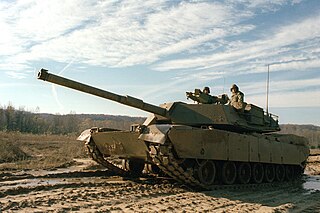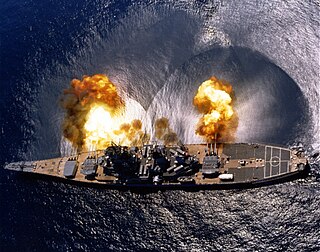Related Research Articles

Reactive armour is a type of vehicle armour used in protecting vehicles, especially modern tanks, against shaped charges and hardened kinetic energy penetrators. The most common type is explosive reactive armour (ERA), but variants include self-limiting explosive reactive armour (SLERA), non-energetic reactive armour (NERA), non-explosive reactive armour (NxRA), and electric armour. NERA and NxRA modules can withstand multiple hits, unlike ERA and SLERA.

Armour-piercing ammunition (AP) is a type of projectile designed to penetrate armour protection, most often including naval armour, body armour, and vehicle armour.

Composite armour is a type of vehicle armour consisting of layers of different materials such as metals, plastics, ceramics or air. Most composite armours are lighter than their all-metal equivalent, but instead occupy a larger volume for the same resistance to penetration. It is possible to design composite armour stronger, lighter and less voluminous than traditional armour, but the cost is often prohibitively high, restricting its use to especially vulnerable parts of a vehicle. Its primary purpose is to help defeat high-explosive anti-tank (HEAT) projectiles.

Chobham armour is the informal name of a composite armour developed in the 1960s at the Military Vehicles and Engineering Establishment, a British tank research centre on Chobham Lane in Chertsey. The name has since become the common generic term for composite ceramic vehicle armour. Other names informally given to Chobham armour include Burlington and Dorchester. Special armour is a broader informal term referring to any armour arrangement comprising sandwich reactive plates, including Chobham armour.

An ironclad was a steam-propelled warship protected by steel or iron armor constructed from 1859 to the early 1890s. The ironclad was developed as a result of the vulnerability of wooden warships to explosive or incendiary shells. The first ironclad battleship, Gloire, was launched by the French Navy in November 1859, narrowly preempting the British Royal Navy. However, Britain built the first completely iron-hulled warships.

A shell, in a military context, is a projectile whose payload contains an explosive, incendiary, or other chemical filling. Originally it was called a bombshell, but "shell" has come to be unambiguous in a military context. A shell can hold a tracer.
Rolled homogeneous armour (RHA) is a type of vehicle armour made of a single steel composition hot-rolled to improve its material characteristics, as opposed to layered or cemented armour. Its first common application was in tanks. After World War II, it began to fall out of use on main battle tanks and other armoured fighting vehicles intended to see front-line combat as new anti-tank weapon technologies were developed which were capable of relatively easily penetrating rolled homogeneous armour plating even of significant thickness.

Military vehicles are commonly armoured to withstand the impact of shrapnel, bullets, shells, rockets, and missiles, protecting the personnel inside from enemy fire. Such vehicles include armoured fighting vehicles like tanks, aircraft, and ships.

Naval artillery is artillery mounted on a warship, originally used only for naval warfare and then subsequently used for more specialized roles in surface warfare such as naval gunfire support (NGFS) and anti-aircraft warfare (AAW) engagements. The term generally refers to powder-launched projectile-firing weapons and excludes self-propelled projectiles such as torpedoes, rockets, and missiles and those simply dropped overboard such as depth charges and naval mines.

Harvey armor was a type of steel naval armor developed in the early 1890s in which the front surfaces of the plates were case hardened. The method for doing this was known as the Harvey process, and was invented by the American engineer Hayward Augustus Harvey.

Krupp armour was a type of steel naval armour used in the construction of capital ships starting shortly before the end of the nineteenth century. It was developed by Germany's Krupp Arms Works in 1893 and quickly replaced Harvey armour as the primary method of protecting naval ships, before itself being supplanted by the improved Krupp cemented armour.
A muzzle-loading rifle is a muzzle-loaded small arm or artillery piece that has a rifled barrel rather than a smoothbore. The term "rifled muzzle loader" typically is used to describe a type of artillery piece, although it is technically accurate for small arms as well. A shoulder arm is typically just called a "rifle", as almost all small arms were rifled by the time breechloading became prevalent. Muzzle and breechloading artillery served together for several decades, making a clear distinction more important. In the case of artillery, the abbreviation "RML" is often prefixed to the guns designation; a Rifled breech loader would be "RBL", or often just "BL", since smoothbore breechloading artillery is almost nonexistent. A muzzle loading weapon is loaded through the muzzle, or front of the barrel. This is the opposite of a breech-loading weapon or rifled breechloader (RBL), which is loaded from the breech-end of the barrel. The rifling grooves cut on the inside of the barrel cause the projectile to spin rapidly in flight, giving it greater stability and hence range and accuracy than smoothbore guns. Hand held rifles were well-developed by the 1740s. A popularly recognizable form of the "muzzleloader" is the Kentucky Rifle, which was actually developed in Pennsylvania. The American Longrifle evolved from the German "Jäger" rifle.

Petr Velikiy was an ironclad turret ship built for the Imperial Russian Navy during the 1870s. Her engines and boilers were defective, but were not replaced until 1881. The ship made a cruise to the Mediterranean after they were installed, and before returning to the Baltic Fleet, where she remained for the rest of her career. She did not, like the rest of the Baltic Fleet, participate in the Russo-Turkish War of 1877–1878. Petr Veliky was deemed obsolete by the late 1890s, but she was not ordered to be converted into a gunnery training ship until 1903.

Iron armour was a type of naval armour used on warships and, to a limited degree, fortifications. The use of iron gave rise to the term ironclad as a reference to a ship 'clad' in iron. The earliest material available in sufficient quantities for armouring ships was iron, wrought or cast. While cast iron has never been used for naval armour, it did find a use in land fortifications, presumable due to the lower cost of the material. One well known example of cast-iron armour for land use is the Gruson turret, first tested by the Prussian government in 1868. Armoured ships may have been built as early as 1203, in the far east. In the West, they first become common when France launched the first ocean-going ironclad La Gloire in 1859. The British Navy responded with HMS Warrior in 1860, triggering a naval arms race with bigger, more heavily armed and armoured ironclads.

An Armstrong gun was a uniquely designed type of rifled breech-loading field and heavy gun designed by Sir William Armstrong and manufactured in England beginning in 1855 by the Elswick Ordnance Company and the Royal Arsenal at Woolwich. Such guns involved a built-up gun construction system of a wrought-iron tube surrounded by a number of wrought-iron strengthening coils shrunk over the inner tube to keep it under compression.

HMS Inflexible was a Victorian ironclad battleship carrying her main armament in centrally placed turrets. The ship was constructed in the 1870s for the Royal Navy to oppose the perceived growing threat from the Italian Regia Marina in the Mediterranean.

The 100-ton gun was the heaviest gun of the world for quite some time and got a lot of media attention. It was a 17.72-inch (450 mm) rifled muzzle-loading (RML) gun made by Elswick Ordnance Company, the armaments division of the British manufacturing company Armstrong Whitworth, owned by William Armstrong. The 15 guns Armstrong made were used to arm two Italian battleships and, to counter these, British fortifications at Malta and Gibraltar.

The 68-pounder cannon was an artillery piece designed and used by the British Armed Forces in the mid-19th century. The cannon was a smoothbore muzzle-loading gun manufactured in several weights, the most common being 95 long cwt (4,800 kg), and fired projectiles of 68 lb (31 kg). Colonel William Dundas designed the 112 cwt version in 1841 and it was cast the following year. The most common variant, weighing 95 cwt, dates from 1846. It entered service with the Royal Artillery and the Royal Navy and saw active service with both arms during the Crimean War. Over 2,000 were made and it gained a reputation as the finest smoothbore cannon ever made.
Naval armor refers to the various protections schemes employed by warships. The first ironclad warship was created in 1859, and the pace of armour advancement accelerated quickly thereafter. The emergence of battleships around the turn of the 20th century saw ships become increasingly large and well armoured. Vast quantities of heavily armoured ships were used during the World Wars, and were crucial in the outcome. The emergence of guided missiles in the last part of the 20th century has greatly reduced the utility of armor, and most modern warships are now only lightly armored.

The 28 cm L/20 M67 was a Russian early breech loading rifled built-up gun designed by Krupp. It was built for the Russian navy and coastal artillery by both Krupp and Obukhov. The gun was the predecessor of the Krupp 28 cm RK L/22 and the Obukhov 28 cm L/22 M77.
References
- ↑ [Erwin Sieche: Kreuzer und Kreuzerprojekte der k.u.k. Kriegsmarine 1889–1918. E. S. Mittler & Sohn u. a., Hamburg u. a. 2002, ISBN 3-8132-0766-8, S. 17.]
- ↑ Edwards, William Egerton (1911). . In Chisholm, Hugh (ed.). Encyclopædia Britannica . Vol. 2 (11th ed.). Cambridge University Press. pp. 578–582.